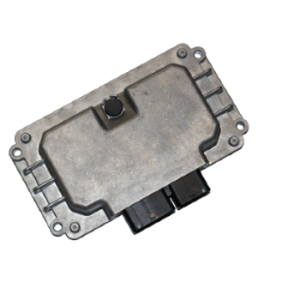GCM80: Difference between revisions
No edit summary |
|||
| (29 intermediate revisions by 4 users not shown) | |||
| Line 1: | Line 1: | ||
= | ==Overview== | ||
[[File:GCM80.png|300px]] | [[File:GCM80.png|300px]] | ||
The GCM80 is a general purpose control module | The GCM80 is a general-purpose control module with four CAN buses, one LIN bus and a large variety of I/O. It also has a secondary processor, making it capable of working safety-critical applications. | ||
The GCM80 is part of a family of rugged, automotive-grade production controllers that use | The GCM80 is part of a family of rugged, automotive-grade production controllers that use New Eagle's software development process based on MATLAB/Simulink, Raptor-Dev. '''[[Raptor-Dev]]''' significantly speeds up algorithm development by using automatic code generation. In addition, developers can quickly test application software on their PCs with a built-in onscreen PC simulation. | ||
== | ==Version Differences== | ||
{| class="wikitable" style="text-align: center;" cellpadding = "5" | |||
: | |||
== | !scope="col"|New Eagle Part Number | ||
!scope="col"|GCM-5607B-080-1901 | |||
!scope="col"|GCM-5607B-080-1903 | |||
!scope="col"|GCM-5607B-080-2002 | |||
|- | |||
== | !scope="col"|Internal Termination | ||
!scope="col"| | |||
!scope="col"| | |||
!scope="col"| | |||
|- | |||
|- style="vertical-align:middle;" | |||
|style = "width:400px;"| | |||
CAN1 Termination (120Ω between B-A1 and B-B1) | |||
|style = "width:180px;"| | |||
Yes | |||
|style = "width:180px;"| | |||
No | |||
|style = "width:180px;"| | |||
Yes | |||
|- style="vertical-align:middle;" | |||
|style = "width:400px;"| | |||
CAN2 Termination (120Ω between B-C1 and B-D1) | |||
|style = "width:180px;"| | |||
Yes | |||
|style = "width:180px;"| | |||
No | |||
|style = "width:180px;"| | |||
Yes | |||
|- style="vertical-align:middle;" | |||
|style = "width:400px;"| | |||
CAN3 Termination (120Ω between B-E1 and B-F1) | |||
|style = "width:180px;"| | |||
Yes | |||
|style = "width:180px;"| | |||
No | |||
|style = "width:180px;"| | |||
Yes | |||
|- style="vertical-align:middle;" | |||
|style = "width:400px;"| | |||
CAN4 Termination (120Ω between A-K2 and A-J2) | |||
|style = "width:180px;"| | |||
Yes | |||
|style = "width:180px;"| | |||
No | |||
|style = "width:180px;"| | |||
Yes | |||
|- style="vertical-align:middle;" | |||
!scope="col"|Internal Shunts | |||
!scope="col"| | |||
!scope="col"| | |||
!scope="col"| | |||
|- | |||
== FAQ == | |- style="vertical-align:middle;" | ||
|style = "width:400px;"| | |||
0Ω Shunt between AF4/AK3 | |||
|style = "width:180px;"| | |||
Yes | |||
|style = "width:180px;"| | |||
No | |||
|style = "width:180px;"| | |||
No | |||
|- style="vertical-align:middle;" | |||
|style = "width:400px;"| | |||
0Ω Shunt between AF3/AK4 | |||
|style = "width:180px;"| | |||
Yes | |||
|style = "width:180px;"| | |||
No | |||
|style = "width:180px;"| | |||
No | |||
|- style="vertical-align:middle;" | |||
|style = "width:400px;"| | |||
0Ω Shunt between AE3/AJ4 | |||
|style = "width:180px;"| | |||
Yes | |||
|style = "width:180px;"| | |||
No | |||
|style = "width:180px;"| | |||
No | |||
|- style="vertical-align:middle;" | |||
|style = "width:400px;"| | |||
0Ω Shunt between AE4/AJ3 | |||
|style = "width:180px;"| | |||
Yes | |||
|style = "width:180px;"| | |||
No | |||
|style = "width:180px;"| | |||
No | |||
|} | |||
==<div style="font-size:21px; width:75%; font-weight:bold; text-align:left; padding-top:7px; padding-bottom:7px; background:#800020; color:white;">Downloads</div>== | |||
===Datasheets=== | |||
'''GCM-5607B-80-1901''' | |||
:'''[https://neweagle.net/support/wiki/ProductDocumentation/Raptor/Controllers/GCM-5607B-080-1901_DataSheet.pdf Datasheet]''' | |||
'''GCM-5607B-80-1903''' | |||
:'''[https://neweagle.net/support/wiki/ProductDocumentation/Raptor/Controllers/GCM-5607B-080-1903_DataSheet.pdf Datasheet]''' | |||
'''GCM-5607B-80-2001''' | |||
:'''[https://neweagle.net/support/wiki/ProductDocumentation/Raptor/Controllers/GCM-5607B-080-2001_DataSheet.pdf Datasheet]''' | |||
===CAD Model=== | |||
:'''[https://neweagle.net/support/wiki/ProductDocumentation/Controllers/GCM-5607B-080-1901/GCM80.zip GCM80 3D Model]''' | |||
=== Compiler === | |||
'''Code Warrior 2.10''' | |||
:Available from [https://www.nxp.com/support/developer-resources/software-development-tools/codewarrior-development-tools/codewarrior-legacy/codewarrior-development-studios/codewarrior-for-microcontrollers/codewarrior-development-studio-for-mpc55xx-mpc56xx-classic-ide-v2.10:CW-MPC55XX_56XX NXP] | |||
== Frequently Asked Questions (FAQ) == | |||
There are no FAQs for this page. | |||
Latest revision as of 19:59, 10 March 2023
Overview
The GCM80 is a general-purpose control module with four CAN buses, one LIN bus and a large variety of I/O. It also has a secondary processor, making it capable of working safety-critical applications.
The GCM80 is part of a family of rugged, automotive-grade production controllers that use New Eagle's software development process based on MATLAB/Simulink, Raptor-Dev. Raptor-Dev significantly speeds up algorithm development by using automatic code generation. In addition, developers can quickly test application software on their PCs with a built-in onscreen PC simulation.
Version Differences
| New Eagle Part Number | GCM-5607B-080-1901 | GCM-5607B-080-1903 | GCM-5607B-080-2002 |
|---|---|---|---|
| Internal Termination | |||
|
CAN1 Termination (120Ω between B-A1 and B-B1) |
Yes |
No |
Yes |
|
CAN2 Termination (120Ω between B-C1 and B-D1) |
Yes |
No |
Yes |
|
CAN3 Termination (120Ω between B-E1 and B-F1) |
Yes |
No |
Yes |
|
CAN4 Termination (120Ω between A-K2 and A-J2) |
Yes |
No |
Yes |
| Internal Shunts | |||
|
0Ω Shunt between AF4/AK3 |
Yes |
No |
No |
|
0Ω Shunt between AF3/AK4 |
Yes |
No |
No |
|
0Ω Shunt between AE3/AJ4 |
Yes |
No |
No |
|
0Ω Shunt between AE4/AJ3 |
Yes |
No |
No |
Downloads
Datasheets
GCM-5607B-80-1901
GCM-5607B-80-1903
GCM-5607B-80-2001
CAD Model
Compiler
Code Warrior 2.10
- Available from NXP
Frequently Asked Questions (FAQ)
There are no FAQs for this page.
